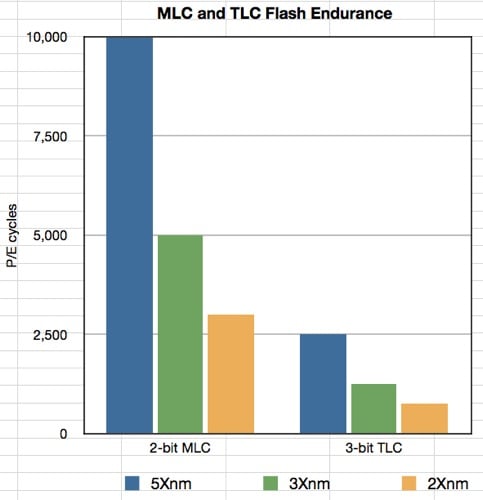This article is more than 1 year old
Enterprise storage: A history of paper, rust and flash silicon
Has anything really changed since the punch card era?
All types of flash
Flash comes in three varieties. Single layer cell (SLC) flash stores one bit per cell and is the fastest and most expensive form of flash. Its problem is that it has a limited number of Program/Erase (P/E) cycles before it dies.

Flash with 2 bits per cell is called Multi-layer cell or MLC flash. It has a higher capacity than SLC flash, but is slower, and although cheaper, has a shorter working life. Three bit flash is called TLC (Triple Layer Cell) is cheaper still, slower and shorter-lived than MLC flash, as the graphic shows, and it's used in digital cameras and similar devices where a P/E cycle limit of 2,500 or so is acceptable.
While flash endurance can be lengthened by over-provisioning; providing spare unused cells to replace worn-out ones, there is another problem. The only way to increase flash's areal density is to shrink the cell size. But as we do this, moving from a 40nm-class cell size (49-40nm range), to 30nm class, 20nm class and below, the flash cell's endurance also diminishes. Today's leading-edge flash is 16nm. There may be one smaller iteration but then some form of stacking NAND dies, one atop another, will be needed, and Samsung has already announced its 3D V-NAND drive.

Flash memory die
Flash memory for desktop and server computers is mostly packaged in disk drive, bay-sized cases - 2.5-in typically - and called a Solid State Drive or SSD. It uses disk-derived access interfaces, SATA or SAS.
Computers using flash memory can access data in microseconds whereas data access with disk drives needs milliseconds because the disk's head has to be moved to the right track. As a result, computers using flash can run applications faster, supporting more virtual machines in virtualised servers.
Another way of providing flash is to connect it directly to the internal PCIe bus, this providing even faster access to its data as no disk I/O conversion is needed. Such PCIe flash card memory is rapidly growing in popularity with 16TB coming next year from Micron.
SSDs or flash built into cards, such as Violin Memory's VIMMs, can be used to create networked all-flash arrays which are faster-reacting than hard disk drive arrays, need approximately a tenth or less of the physical space, and a tenth of the power. Deduplication can be used to increase their effective capacity and provide a cost/GB of stored data comparable to or better than disk drive arrays.
Disk drive array manufacturers are now using SSDs to store the most active data, as well as flash caches in their controllers to speed data access. It is likely that most primary data currently stored in disk drive arrays will move over time to all-flash arrays.
Disk drives will be used to store secondary or nearline data. Hybrid arrays use flash for primary data and disk for secondary data, offering a halfway house between all-flash arrays and all-disk arrays, being less expensive than the former and faster than the latter while still having disk-levels of capacity.
Over time flash technology will run out of steam and a replacement will be needed. Currently, either Phase-Change Memory or Resistive RAM are seen as the leading candidates, both promising DRAM-like speed, full random access and non-volatility.
Today, the space taken by a hole in a paper tape signifying a single bit can now hold megabits or even gigabits. Storage used to be a technology needing fractions of an inch or centimeter to store visible bits. Now it uses nanometres to store invisible bits accessed at speeds so fast we can barely comprehend them.
Storage needs to carry on getting faster, smaller, cheaper, and more reliable if we are to carry on advancing our use of computers. Truly we have been in, and are in, a store-age as much as a computer age. ®
Bootnote
We have concentrated only on developments in the IT storage industry and not looked at technology developments outside IT that were adopted and taken on board – such as punched cards used in Jaquard looms before their use in computing, paper tape in teletypes and so forth.
